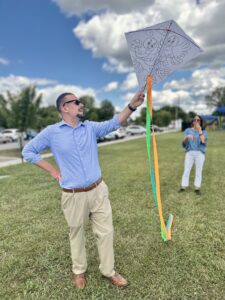By Andrew Adler
Community Editor

JCRC Director Trent Spoolstra tries his hand at kite flying, as colleague Tricia Kling Siegwald looks on.
Nearly two years after the horrific events of October 7, 2023, it would be easy — instinctive, even — for any observance of that anniversary to emphasize themes of abject pessimism. But that’s not what will define Louisville’s principal commemoration, slated for Sunday, Oct. 12 on the grounds of the Trager Family JCC.
Instead, the sky above the Jewish Heritage Fund Campus will be filled with kites, dozens of them — a soaring metaphor for a refusal to give in to the forces of anguish and despair. Louisville’s commemoration was inspired by the event being planned by Columbus, Ohio’s Federation — JewishColumbus.
“Kites of Hope” was inspired by Kibbutz Kfar Aza’s 15-year tradition of the annual Sukkot kite festival, which was cancelled after organizer Aviv Kutz and his family were among 62 residents murdered by Hamas terrorists (who took another 19 civilians hostage) on that fateful October morning.
“We’re taking this idea and adapting it for Louisville,” explained Trent Spoolstra, director of the Jewish Community Relations Council at the Jewish Federation of Louisville. “It’s a different take on what we’ve traditionally done to commemorate October 7, one focused on peace and resilience.”
The upcoming Oct. 12 event has a two-fold imperative: “honoring the Kutz family, but also acknowledging that the war is still going on.,” Spoolstra said. “Hopefully, peace will prevail — ideally, sooner rather than later.”
Hamas’ attack claimed some 1,200 lives and almost 250 hostages — 49 of whom remain in captivity (at latest count, 21 are alive and 28 dead). There is one additional deceased hostage, Hadar Goldin, an IDF lieutenant who was killed in action in 2014. Hamas has held his body ever since.
The Gaza war has raged, with several pauses for cease-fires and prisoner exchanges, for almost two straight years. Tens of thousands of civilians have perished, debilitating hunger is rampant, and the prospects for ending the conflict are – at best — tenuous.
Yet while pragmatists might argue that Gaza’s reality is inevitably bleak, Spoolstra is among those who take a less absolutist stance.
“Yes, we could easily wallow in how horrible the political situation is right now,” he said. “But there are a lot of people — both in the United States and in Israel, who want the war to end. So, I’d argue that an event like this is needed now more than ever — to promote peace and hopefully see an end to the fighting. The focus is not so much on the present, but what do we want the future to be?”
With that spirit in mind, Spoolstra is organizing the purchase of kite kits. Participants — principally young children and teens — will decorate the kites and Oct. 12, launch them into the skies above the Jewish Heritage Fund Campus. The plan is for kite decorating to begin at 12:30 p.m., a brief program starting at 1 p.m., followed by kite flying. If there’s inclement weather the event will move indoors.
“We’d like to get Jewish students and families involved,” Spoolstra said, “all from Camp J and Sunday schools. The idea is for families to fly the kites on that day. It’s a multi-step process — supplying kites, having the kids decorate them — making them as colorful as possible.”
Kites have long been a powerful vehicle for promoting peace. The Israel Forever Foundation’s “Kites for Hope” initiative “was crafted as a response to the wave of terror happening in Israel in the form of explosives attached to kites flying in from Gaza,” its website explains. “But now we are expanding the meaning of this activity to respond to Jew-hatred all over the world.”
“We’re seeking to both honor and commemorate that which has been lost, while also being able to turn to the future with a more hopeful posture,” said Rabbi Ben Freed of Keneseth Israel Congregation, the event’s chair., “just as kites can rise up and be symbols of hope and freedom. So we’re encouraging ourselves and our children to really take this message to heart.”
In July 2011, children in Gaza sent 12,350 kites aloft, setting a Guinness Book of Records mark for the most kites ever flown simultaneously. Seven years later, Washington, D.C.’s DC Kite Festival also referenced the irony of a child’s toy being employed as a conduit for terrorism. Tzachi Levi, in a July 12, 2018 post on the Jewish Federation of Greater Washington’s website, recalled participating in the festival alongside his 10-year-old son, Oz:
There is a very intimate relationship between a person and his kite. You let go of the kite, but still hold on to the string. You release the string as the kite catches the wind and rises to the sky. Sometimes, you’re not sure if the kite is driving you, or if you are driving the kite. One is holding the ground, the other holding the sky. The string which connects the person and his kite is extremely important. If you disconnect the string, you’ve lost the purpose of the kite altogether.
The people living in the south of Israel have been holding those strings for many years. They are holding the ground, while keeping their heads in the sky. They refuse to give up and remain optimistic: building their communities and continuing to pursue their dreams.
For more information about participating in Louisville’s Oct. 12 “Kites of Hope” event, see the ad below. If you have questions, or want to decorate a kite ahead of time, reach out to JCRC Director Trent Spoolstra at tspoolstra@jewishlouisville.org.
Support for Kites of Hope comes from the Father Stanley Schmidt Fund, the American Jewish Committee Fund, the Jill E. Simon President’s Fund and the Annette & Joseph Gale Fund



